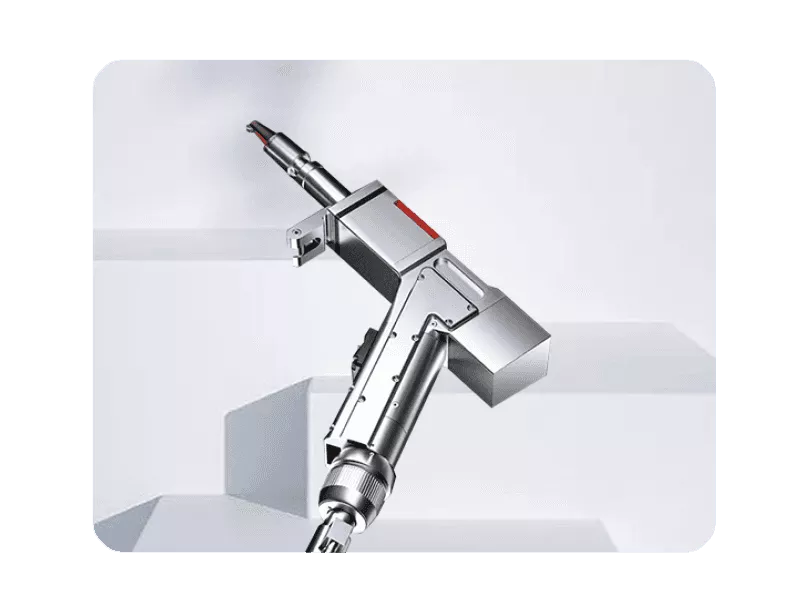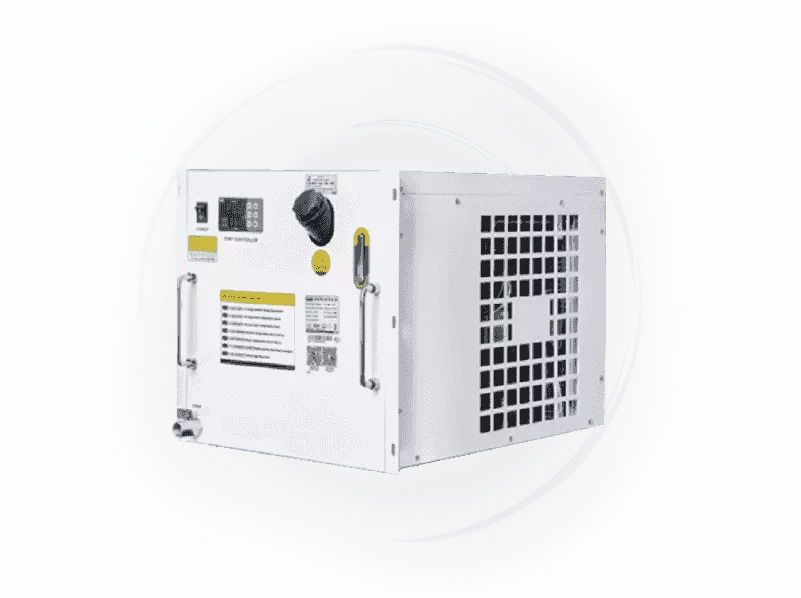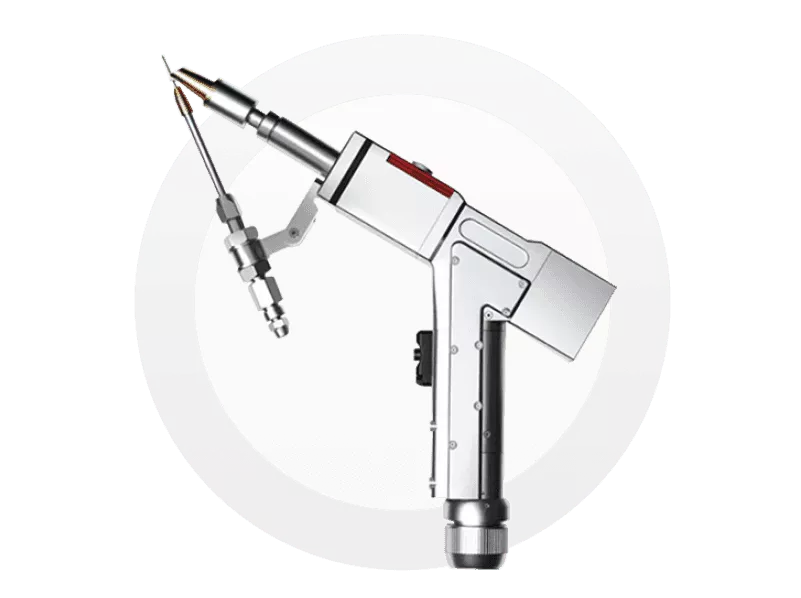What is a Laser Welding Machine?
A Laser Welding Machine is a high-tech tool that uses a laser beam to join materials together. This machine is known for its precision and efficiency. The laser beam is very focused and can melt materials at the joint, allowing them to fuse together as they cool. Laser welding is widely used in various industries such as automotive, aerospace, electronics, and medical device manufacturing. It is favored for its ability to create strong, clean welds quickly and accurately.

Five Most Outstanding Characteristics
- Swing Welding Technology
Laser welding machines equipped with WOBBLE welding heads utilize swing welding technology. This feature allows the welding beam to oscillate or swing during operation. The benefit of this technology is that it can adjust the facula (the focal point of the laser), which significantly improves welding fault tolerance. This means that even if there are slight inaccuracies or variations in the positioning of the parts to be welded, the laser can still produce a high-quality weld. The swing welding technique compensates for the small size of the laser welding spot, extending the tolerance range and weld width. This results in better weld formation and more robust joints. - Work-piece Welding in One Operation
One of the standout features of laser welding machines is their ability to weld an entire work-piece in a single operation. This makes the process straightforward and highly efficient. The operation is simple enough that users can be trained quickly, reducing the learning curve associated with traditional welding methods. The laser head itself is light and flexible, capable of reaching and welding any part of the work-piece. This flexibility ensures that the machine can handle complex welding tasks, making it ideal for intricate designs and hard-to-reach areas. This not only boosts productivity but also enhances safety and energy efficiency, as the process is completed faster and with less energy consumption. - Dual Temperature and Control Chiller
Laser welding machines come equipped with a dual temperature and control chiller. This system is crucial for maintaining a constant temperature during operation. The chiller ensures that the core optical components of the laser, as well as the fiber laser itself, do not overheat. By providing effective heat dissipation, the chiller contributes to the machine’s stability and efficiency. This feature is essential for maintaining consistent performance over long periods, preventing overheating, and extending the lifespan of the machine. - High Efficiency and Precision
Efficiency and precision are hallmark qualities of laser welding machines. These machines can complete welding tasks much faster than traditional methods, which is particularly beneficial in high-production environments. The precision offered by laser welding is unparalleled, making it possible to achieve detailed and accurate welds. This high level of precision is especially important in industries where even the smallest defect can lead to significant issues, such as in the manufacturing of medical devices or aerospace components. The ability to produce precise welds reduces the need for rework and minimizes material waste. - Energy Efficient and Environmentally Friendly
Laser welding machines are designed to be energy-efficient, consuming less power compared to conventional welding techniques. This not only reduces operational costs but also makes the process more sustainable. Additionally, laser welding produces less waste and fewer emissions, contributing to a cleaner work environment. The reduced energy consumption and minimal environmental impact make laser welding an attractive option for companies looking to improve their sustainability practices.
Best Advice for Users of Laser Welding Machines

- Proper Training
It is essential to receive proper training before operating a laser welding machine. Training ensures that users understand the machine’s functionalities and can operate it safely and efficiently. Well-trained operators are better equipped to utilize the machine’s features fully, leading to higher quality welds and improved productivity. - Regular Maintenance
Regular maintenance is key to keeping a laser welding machine in good working condition. Routine checks and servicing help prevent unexpected breakdowns and extend the machine’s lifespan. Maintenance tasks include cleaning the lens, checking the cooling system, and ensuring that all components are functioning correctly. - Use Correct Settings
Using the correct settings for each welding task is crucial. The laser power, speed, and other parameters should be adjusted based on the material and thickness being welded. Incorrect settings can lead to poor weld quality and potential damage to the machine or work-piece. - Safety Measures
Safety should always be a top priority when using a laser welding machine. Operators should wear appropriate protective gear, such as gloves, safety glasses, and protective clothing. It is also important to follow all safety guidelines and protocols to prevent accidents and injuries. - Environment Control
Using the laser welding machine in a controlled environment is important for achieving the best results. The workspace should be clean and free of dust and debris that could interfere with the welding process. Proper ventilation is also necessary to ensure that fumes generated during welding are safely removed from the work area.
Advantages and Disadvantages
Advantages
- High Precision
Laser welding offers precise control over the welding process, resulting in detailed and accurate welds. This precision is particularly beneficial for applications that require tight tolerances and high-quality finishes. - Speed
The laser welding process is fast, which can significantly reduce production time and increase overall efficiency. This speed advantage is especially valuable in high-volume manufacturing settings. - Versatility
Laser welding machines are versatile and can be used on a wide range of materials, including metals, plastics, and ceramics. This makes them suitable for various industries and applications. - Clean Welds
Laser welding produces clean welds with minimal distortion and spatter. This reduces the need for post-weld cleaning and finishing, saving time and effort. - Energy Efficiency
Laser welding machines are energy-efficient, using less power compared to traditional welding methods. This leads to lower operating costs and a reduced environmental footprint.
Disadvantages
- High Initial Cost
The initial cost of purchasing a laser welding machine can be high, making it a significant investment. However, the long-term benefits and savings can offset this initial expense. - Complexity
Operating a laser welding machine requires specialized knowledge and training. The complexity of the equipment and process can be a barrier for some users. - Maintenance
Regular maintenance is necessary to keep the machine in optimal condition. This can involve additional costs and downtime for servicing. - Material Limitations
While laser welding is versatile, it may not be suitable for all materials. Some materials may require special preparation or specific laser settings to achieve satisfactory results. - Safety Concerns
Laser welding involves high-intensity laser beams, which can pose safety risks if not handled properly. Strict adherence to safety protocols is essential to prevent accidents and injuries.
Detailed Technical Specifications of Laser Welding Machine

Power Output
Laser welding machines typically offer a wide range of power outputs, from 500W to 6000W. This flexibility allows users to select the appropriate power level for their specific welding tasks. The power output can be adjusted to accommodate different materials and thicknesses, ensuring optimal welding performance.
Laser Source
The laser source used in these machines is usually a fiber laser, known for its efficiency and stable output. The wavelength of the laser beam is commonly in the range of 1070-1080 nm, which is suitable for welding various metals. Fiber lasers are preferred because they provide consistent performance and require less maintenance compared to other types of lasers.
Welding Speed
The welding speed of laser welding machines can vary significantly, from a few millimeters per second to several meters per second. This speed range allows the machine to handle both delicate and large-scale welding tasks. The ability to adjust the welding speed is crucial for achieving the desired weld quality and ensuring the process is efficient.
Beam Quality
The quality of the laser beam is a critical factor in laser welding. The spot size of the laser beam can be adjusted, typically ranging from 0.2 mm to 2.0 mm. Swing welding technology enhances beam quality by allowing the beam to oscillate, improving fault tolerance and weld formation. This results in stronger and more reliable welds.
Control System
Laser welding machines are equipped with advanced control systems that provide precise control over welding parameters. The user interface is designed to be user-friendly, making it easy to program and operate the machine. The control system allows users to adjust settings such as laser power, speed, and beam focus to match the specific requirements of each welding task.
Cooling System
To ensure stable operation, laser welding machines include a dual temperature and control chiller. This cooling system maintains a constant temperature, preventing the machine from overheating during prolonged use. Effective heat dissipation is essential for maintaining the performance and longevity of the core optical components and the fiber laser.
Dimensions and Weight
Laser welding machines are designed to be compact and lightweight, allowing for easy integration into various workspaces. The specific dimensions and weight of the machine can vary depending on the model, but most machines are designed to be portable and easy to maneuver.
Safety Features
Safety is a top priority in laser welding machines. These machines are equipped with various protective measures, including safety interlocks, emergency stop functions, and protective casings. These features help minimize the risk of accidents and ensure the operator’s safety.
Electrical Requirements
Laser welding machines typically require a voltage supply of 220V or 380V, depending on the model. They are designed to be energy-efficient, reducing power consumption and operating costs. It is important to ensure that the electrical supply meets the machine’s requirements to avoid any issues during operation.
Environmental Conditions
Laser welding machines are designed to operate in a range of environmental conditions. The recommended operating temperature is usually between 15°C and 35°C, and the machine should be used in a controlled environment to prevent condensation and damage. Proper ventilation is also necessary to ensure a safe and efficient welding process.
Alternatives to Laser Welding Machine
If a laser welding machine does not suit your needs, there are alternative welding technologies that you can consider. These alternatives offer different benefits and may be more suitable for certain applications.
MIG Welding (Metal Inert Gas Welding)
MIG welding uses a continuous wire feed as an electrode and an inert gas to shield the weld from contamination. This method is suitable for welding thicker materials and provides strong, reliable welds. MIG welding is commonly used in industries such as automotive and construction.
TIG Welding (Tungsten Inert Gas Welding)
TIG welding uses a non-consumable tungsten electrode and an inert gas for shielding. This method provides high precision and is ideal for welding thin materials and detailed work. TIG welding is widely used in industries such as aerospace and electronics.
Plasma Arc Welding
Plasma arc welding uses a plasma torch to generate a high-temperature plasma arc for welding. This method offers high precision and control, similar to laser welding, but can be more complex to operate. Plasma arc welding is suitable for a wide range of materials and applications.
Basic Technical Specifications and Advantages and Disadvantages for Suggested Products

MIG Welding Machine
Technical Specifications
- Power Output: 30-300A
- Voltage: 110V/220V
- Wire Feed Speed: Adjustable, typically 1-10 m/min
- Weight: 20-30 kg
Advantages
- Versatility
MIG welding machines are versatile and can handle a wide range of materials and thicknesses. This makes them suitable for various applications, from automotive repair to construction. - Ease of Use
MIG welding is relatively simple to operate, making it accessible even for beginners. The continuous wire feed and straightforward controls make the process user-friendly. - Speed
The welding process is fast, allowing for high productivity and efficiency. This is particularly beneficial in high-production environments where time is a critical factor.
Disadvantages
- Weld Quality
While MIG welding provides strong welds, it can produce spatter, which may require additional cleaning and finishing. This can add to the overall time and cost of the welding process. - Material Limitations
MIG welding is not ideal for thin or delicate materials, as the high heat input can cause distortion or damage. It is better suited for thicker materials and structural applications.
TIG Welding Machine
Technical Specifications
- Power Output: 10-200A
- Voltage: 110V/220V
- Torch Type: Air-cooled or water-cooled
- Weight: 15-25 kg
Advantages
- Precision
TIG welding provides high precision and control, making it ideal for detailed work and applications that require fine welds. The non-consumable tungsten electrode allows for consistent and accurate welds. - Clean Welds
TIG welding produces clean welds with minimal spatter and distortion. This reduces the need for post-weld cleaning and results in a higher-quality finish. - Material Flexibility
TIG welding is suitable for welding thin materials and a wide range of metals, including aluminum, stainless steel, and titanium. This makes it a versatile option for various industries.
Disadvantages
- Speed
The TIG welding process is slower compared to other methods, which can be a disadvantage in high-production environments. The precise nature of TIG welding requires more time and attention to detail. - Complexity
TIG welding requires skilled operators and more practice to master. The complexity of the process and the need for precise control can be challenging for beginners.
Plasma Arc Welding Machine
Technical Specifications
- Power Output: 10-200A
- Voltage: 110V/220V
- Torch Type: Air-cooled or water-cooled
- Weight: 20-30 kg
Advantages
- Precision
Plasma arc welding offers high precision and control, similar to laser welding. This makes it suitable for applications that require detailed and accurate welds. - Versatility
Plasma arc welding machines can handle a wide range of materials and thicknesses, making them versatile for various applications. They are used in industries such as aerospace, automotive, and manufacturing. - Quality
Plasma arc welding produces high-quality welds with minimal distortion. The plasma torch provides a concentrated heat source, resulting in strong and clean welds.
Disadvantages
- Complexity
Plasma arc welding is more complex to operate compared to MIG and TIG welding. It requires specialized knowledge and training to use effectively. - Cost
The initial cost of plasma arc welding machines can be high, and they require regular maintenance. This can make them a more expensive option compared to other welding methods.
Frequently Asked Questions
Q1: What materials can a laser welding machine weld?
A: Laser welding machines can weld a variety of materials, including metals like stainless steel, aluminum, titanium, and more. They are suitable for both thin and thick materials, making them versatile for different applications.
Q2: Is laser welding safe to use?
A: Yes, laser welding is safe when proper safety protocols are followed. Operators should wear protective gear such as gloves and safety glasses and follow the manufacturer’s safety guidelines to prevent accidents and injuries.
Q3: How long does it take to learn laser welding?
A: The time it takes to learn laser welding varies depending on the individual and the complexity of the welding tasks. With proper training and practice, most users can become proficient in a few weeks.
Q4: What are the maintenance requirements for a laser welding machine?
A: Regular maintenance is essential to keep a laser welding machine in good working condition. This includes cleaning the lens, checking the cooling system, and ensuring all components are functioning correctly. Following the manufacturer’s maintenance schedule can help prevent breakdowns and extend the machine’s lifespan.
Q5: Can laser welding be used for outdoor applications?
A: Laser welding is typically used in controlled environments to ensure optimal performance. For outdoor applications, proper protection against weather conditions and environmental factors is necessary to maintain the quality of the weld.
Q6: How does laser welding compare to traditional welding methods?
A: Laser welding offers higher precision, speed, and cleaner welds compared to traditional welding methods. However, it has a higher initial cost and requires skilled operation. The advantages of laser welding, such as reduced material waste and lower operating costs, often outweigh the disadvantages.
Q7: What is the lifespan of a laser welding machine?
A: With proper maintenance and care, a laser welding machine can last several years. The lifespan depends on factors such as usage, maintenance, and the operating environment.
Q8: Can laser welding be automated?
A: Yes, laser welding can be integrated into automated systems for high-volume production. Automation increases efficiency and consistency, making it suitable for large-scale manufacturing operations.
Conclusion
Laser Welding Machines are a powerful tool for precise and efficient welding. They offer many advantages, including high precision, speed, and energy efficiency, making them an excellent choice for various industries. Whether you are in the automotive, aerospace, or electronics industry, a laser welding machine can significantly improve your welding process and product quality.
Call to Buy Laser Welding Machine at Beginwelding.com
For reliable and high-quality laser welding machines, visit Beginwelding.com today. Enjoy excellent service and top-notch products tailored to your welding needs.
Leave a Reply